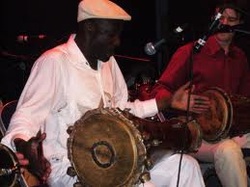Musical Liturgies

A Batá Drummer
Singing, drumming and dancing are liturgies that follow a sacred formula for communication with the Orichás. In Cuba, the Lucumí word Oro (or Oru) is used to describe these musical liturgies. Oro means conversation or word, stressing the idea that music and dancing are ways to speak to the Orichás. One type of oro is unaccompanied singing featuring African-style call and response; the akpwon (lead singer) calls out to a group, who answer in unison. These songs function as prayers, asking for the blessings of the Orichás and for permission to carry out the ceremony. The oro seco or oro del igbodú is unaccompanied batá drumming. Again, the purpose is to ask for the permission of the Orichás to carry out the ceremony, and to invite them to participate in the ceremony that follows. These first two liturgies are private, held inside the igbodú (sacred space of the house), and not open to people who haven't been fully initiated into the religion. The oro del eya aranla combines drumming, singing and dancing. It's generally more open to a wider variety of people, including outsiders who can participate on the margins of the sacred space. The oro del eya aranla can last for hours, and normally attracts a large crowd, so most people hold it in the largest space inside the house that's available to them. Participants can spill over into the streets and patio of the house, although the drummers, singers and dancers remain indoors while performing for the Orichás. Once the formal order of the songs has been completed, the drumming, dancing and singing can continue in a more informal way, repeating rhythms that the iya drum or akpwon calls out. The rhythms are usually accompanied by a cow bell or the head of a metal hoe that's struck with a metal stick, and a large gourd (achere) covered loosely with a network of beads (chekere). These instruments fill in the empty spaces between drum beats. Although the drumming ceremony is a festive occasion, it opens and closes on a solemn note out of respect for the Orichás and egun (spirits of the dead.)
Formal and Informal Drumming Ceremonies
Only the consecrated Batá drums (known as fundamento drums) can be played at a formal, liturgical ceremony. Non-consecrated drums can be played at parties for entertainment or for informal gatherings of the Santería community. Drumming ceremonies are called by the Lucumí word wemilere (or guenmilere) or the Spanish word tambor. In Cuba, an informal drumming party is called a Bembé. The kind of dancing associated with bembés is traditional rumba dancing, which maintains some relationship to the rhythms of sacred drumming. In addition to the wemilere ceremony, Santeros/as might offer guiros (one conga drum, 3 chekeres, and a bell) and violines (salon music played by one or more violins).
Other types of ceremonies in Santería include divination readings, healing and spiritual cleansing, events honoring godparents or the Orichás such as an Ocha birthday (anniversary of initiation), and funeral rites. The misa espiritual (spiritual mass conducted by a medium for communication with the dead) is not technically a part of Santería, although some Santeros/as practice it. The special drumming ceremony known as cajón para los muertos (drumming for the dead) is also commonly practiced by some people in the Santería community, but it's not formally part of the Lucumí liturgical music because it incorporates elements borrowed from Spiritism and Palo Monte as well as Santería. It involves a special drum known as the cajón.
Other types of ceremonies in Santería include divination readings, healing and spiritual cleansing, events honoring godparents or the Orichás such as an Ocha birthday (anniversary of initiation), and funeral rites. The misa espiritual (spiritual mass conducted by a medium for communication with the dead) is not technically a part of Santería, although some Santeros/as practice it. The special drumming ceremony known as cajón para los muertos (drumming for the dead) is also commonly practiced by some people in the Santería community, but it's not formally part of the Lucumí liturgical music because it incorporates elements borrowed from Spiritism and Palo Monte as well as Santería. It involves a special drum known as the cajón.
